Home < Places Visited <
Itinerary <
Winter Trip - January-March 2019
Mississippi
We stayed in Clinton, MS. We went to the Mississippi Museum of Natural Science in Jackson, MS and the Mississippi Petrified Forest in Flora, MS.
Mississippi Museum of Natural Science
Mississippi Petrified Forest
Mississippi Museum of Natural Science
The Mississippi Museum of Natural Science is a small museum with displays aimed at kids. Most fossils are from the Pleistocene epoch of time. Most of the fossils are pieces of animals from that period. Some of the animals from that period are: giant sloths, short-faced bears, the American lion, giant tortoises, and saber-toothed cats.
The main mission of the museum is the study and protection of watersheds. A large portion of the museum is dedicated to watershed information and tanks of fish and amphibians.
Outside the museum is a series of nature trails. The trails are mostly short joining loops. Because of the time of year we were there we did not see much wildlife, just some birds and turtles. There was not much for blossoming vegetation. We did enjoy taking a stroll along the trails.
(Pictures)
Mississippi Petrified Forest
The Mississippi Petrified Forest is a privately owned property in Flora, MS. There is a trail that loops around behind the visitor center. Upon paying our admission we received a pamphlet containing information about the petrified wood and development of the surrounding grounds. There are numbered posts along the trail, the pamphlet has information relating to where the posts are located. We thought the best way to describe the place is to reprint paragraphs from the pamphlet with a picture of the location. To view the picture, place the cursor over the blue word(s).
- This cross-section of a modern Sequoia
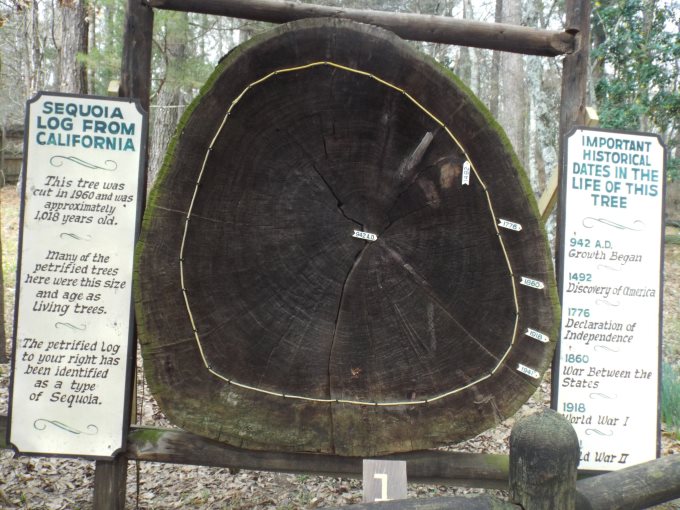 is not petrified but is here to compare with the size and age of petrified logs when they were still living trees. The petrified log
is not petrified but is here to compare with the size and age of petrified logs when they were still living trees. The petrified log to the right of the trail was identified as a Sequoia-like conifer. As a living tree, it measured well over eleven feet in diameter.
to the right of the trail was identified as a Sequoia-like conifer. As a living tree, it measured well over eleven feet in diameter.
- This petrified log
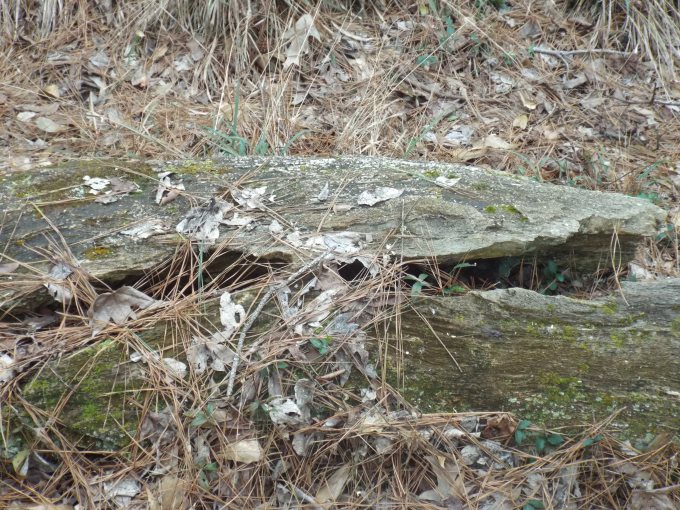 is unusual as the entire heart was decayed, leaving only an outer shell of woody tissue to be replaced by minerals, thus changed to stone.
is unusual as the entire heart was decayed, leaving only an outer shell of woody tissue to be replaced by minerals, thus changed to stone.
- Early scientific studies indicate these ancient trees
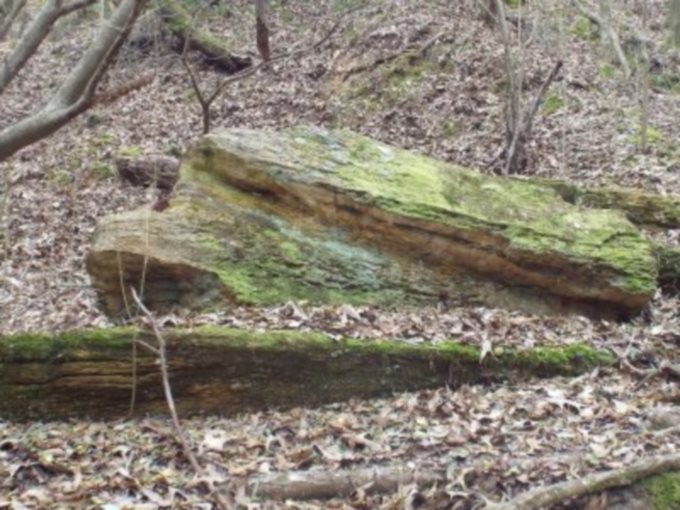 were probably brought here as driftwood, by a prehistoric river. This research indicates that as living trees they grew in the north. Recent studies have indicated some types as those which might have grown in a warmer climate. This area was lowlands, where ancient floods spread soil over plains and shores. Stranded as in a log-jam, they were protected from decay by rapid burial in the soils which also were carried by the murky waters. Petrification (turning to stone) took place during the eons of time of burial. This was accomplished by slow infiltration of minerals present underground, mainly silica. No one knows how long this process of turning from living wood to stone took.
were probably brought here as driftwood, by a prehistoric river. This research indicates that as living trees they grew in the north. Recent studies have indicated some types as those which might have grown in a warmer climate. This area was lowlands, where ancient floods spread soil over plains and shores. Stranded as in a log-jam, they were protected from decay by rapid burial in the soils which also were carried by the murky waters. Petrification (turning to stone) took place during the eons of time of burial. This was accomplished by slow infiltration of minerals present underground, mainly silica. No one knows how long this process of turning from living wood to stone took.
- After being changed into stone, this log
 was broken into sections either by the stress of long burial, natural movements within the earth, or later as uncovered by erosion. The high rise in the background
was broken into sections either by the stress of long burial, natural movements within the earth, or later as uncovered by erosion. The high rise in the background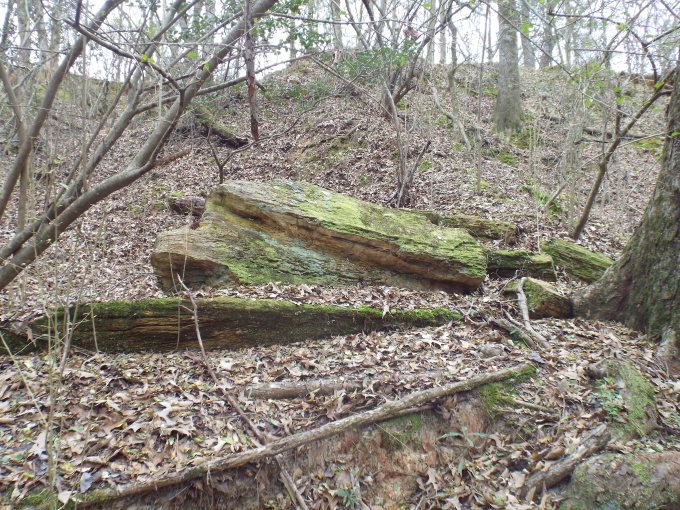 indicates how deeply these logs were buried.
indicates how deeply these logs were buried.
- These petrified logs
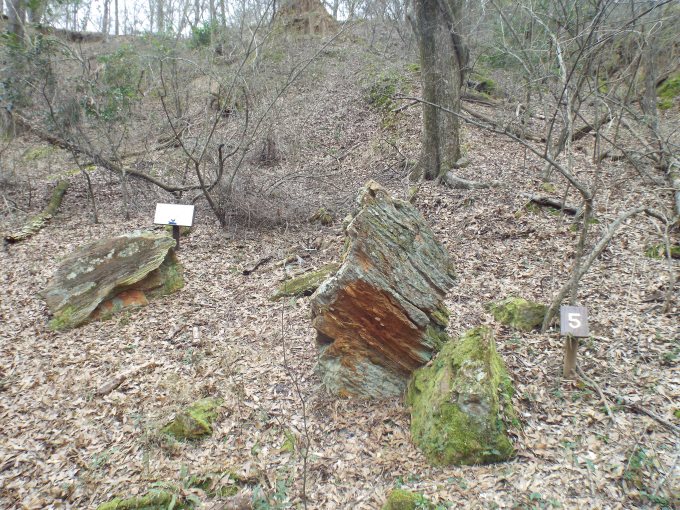 are pieces of one gigantic tree that was broken into a number of segments as it eroded. Those small, flat grayish-green patches on the petrified logs are called lichen
are pieces of one gigantic tree that was broken into a number of segments as it eroded. Those small, flat grayish-green patches on the petrified logs are called lichen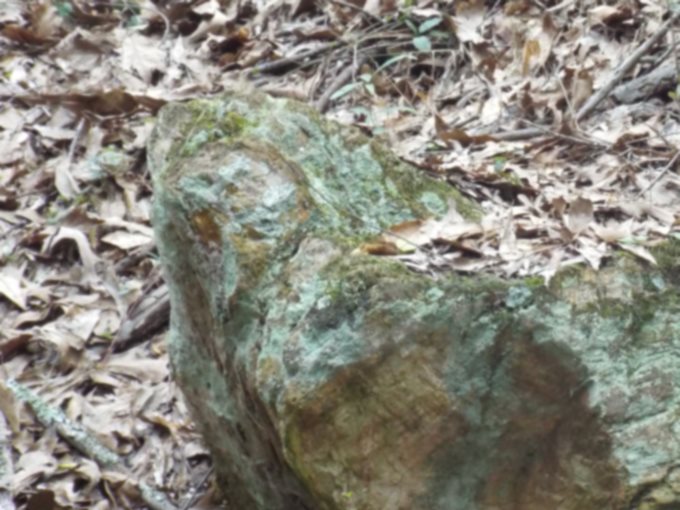 (liken), an algae and a fungus that live and work together. Lichen produces a very weak acid which can etch and slowly turn rock into soil.
(liken), an algae and a fungus that live and work together. Lichen produces a very weak acid which can etch and slowly turn rock into soil.
- The weathered appearance of this log
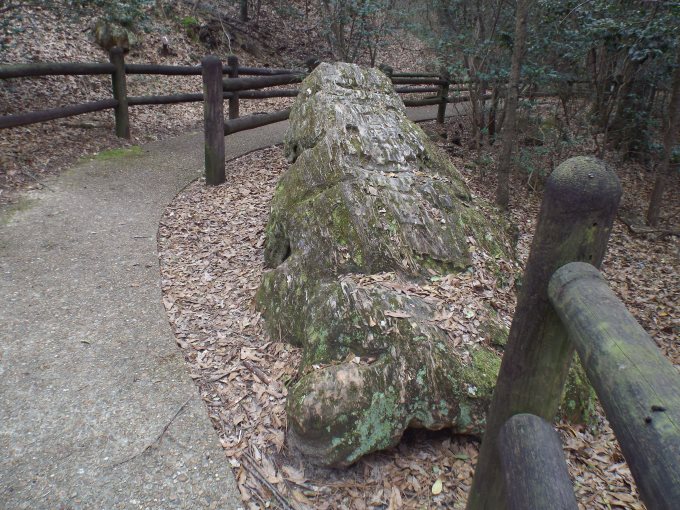 is evidence of its long watery journey as a driftwood tree. It has been calculated that this piece of petrified log weighs 14,940 pounds. Look back to see the "eyes, nose, and mouth" which earned this log the nickname of "Frog"
is evidence of its long watery journey as a driftwood tree. It has been calculated that this piece of petrified log weighs 14,940 pounds. Look back to see the "eyes, nose, and mouth" which earned this log the nickname of "Frog" .
.
This is just a few of the 26 points of interest in the pamphlet, but they show why we found this place very interesting and informative.
Go To Top
Return to ItineraryLast updated:
feb 11 2019
 is not petrified but is here to compare with the size and age of petrified logs when they were still living trees. The petrified log
is not petrified but is here to compare with the size and age of petrified logs when they were still living trees. The petrified log to the right of the trail was identified as a Sequoia-like conifer. As a living tree, it measured well over eleven feet in diameter.
to the right of the trail was identified as a Sequoia-like conifer. As a living tree, it measured well over eleven feet in diameter. is unusual as the entire heart was decayed, leaving only an outer shell of woody tissue to be replaced by minerals, thus changed to stone.
is unusual as the entire heart was decayed, leaving only an outer shell of woody tissue to be replaced by minerals, thus changed to stone. were probably brought here as driftwood, by a prehistoric river. This research indicates that as living trees they grew in the north. Recent studies have indicated some types as those which might have grown in a warmer climate. This area was lowlands, where ancient floods spread soil over plains and shores. Stranded as in a log-jam, they were protected from decay by rapid burial in the soils which also were carried by the murky waters. Petrification (turning to stone) took place during the eons of time of burial. This was accomplished by slow infiltration of minerals present underground, mainly silica. No one knows how long this process of turning from living wood to stone took.
were probably brought here as driftwood, by a prehistoric river. This research indicates that as living trees they grew in the north. Recent studies have indicated some types as those which might have grown in a warmer climate. This area was lowlands, where ancient floods spread soil over plains and shores. Stranded as in a log-jam, they were protected from decay by rapid burial in the soils which also were carried by the murky waters. Petrification (turning to stone) took place during the eons of time of burial. This was accomplished by slow infiltration of minerals present underground, mainly silica. No one knows how long this process of turning from living wood to stone took. was broken into sections either by the stress of long burial, natural movements within the earth, or later as uncovered by erosion. The high rise in the background
was broken into sections either by the stress of long burial, natural movements within the earth, or later as uncovered by erosion. The high rise in the background indicates how deeply these logs were buried.
indicates how deeply these logs were buried. are pieces of one gigantic tree that was broken into a number of segments as it eroded. Those small, flat grayish-green patches on the petrified logs are called lichen
are pieces of one gigantic tree that was broken into a number of segments as it eroded. Those small, flat grayish-green patches on the petrified logs are called lichen (liken), an algae and a fungus that live and work together. Lichen produces a very weak acid which can etch and slowly turn rock into soil.
(liken), an algae and a fungus that live and work together. Lichen produces a very weak acid which can etch and slowly turn rock into soil. is evidence of its long watery journey as a driftwood tree. It has been calculated that this piece of petrified log weighs 14,940 pounds. Look back to see the "eyes, nose, and mouth" which earned this log the nickname of "Frog"
is evidence of its long watery journey as a driftwood tree. It has been calculated that this piece of petrified log weighs 14,940 pounds. Look back to see the "eyes, nose, and mouth" which earned this log the nickname of "Frog" .
.